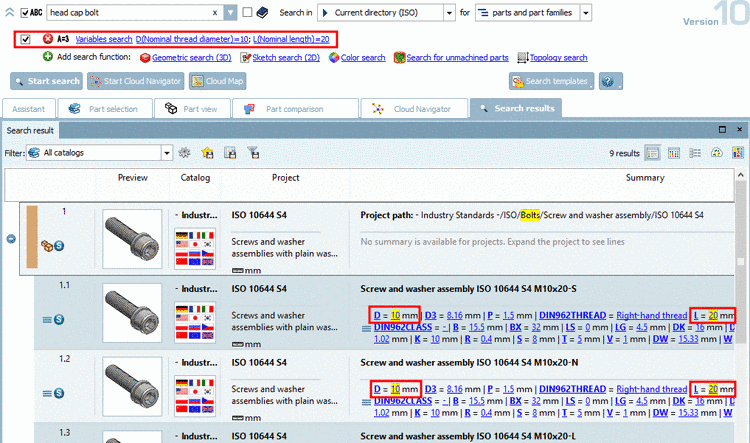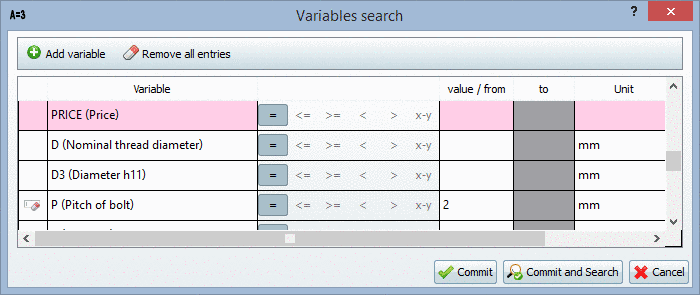Manual
Login
Our 3D CAD supplier models have been moved to 3Dfindit.com, the new visual search engine for 3D CAD, CAE & BIM models.
You can log in there with your existing account of this site.
The content remains free of charge.

Top Links
Manual
In this chapter at first you can find an example on variable search, afterwards the setting options and functions of the Variables search dialog box are explained.
In order to perform a Variables search, proceed as follows:
-
Limit the search at "Current selection (Bolts)"[36] and leave the setting "Search for
 parts and part families".
parts and part families".-> On the right side, in the section Variables for <directory name> the common variables of the selected directory are displayed.
-
-> A selection dialog with the options New search or More precise (AND) opens.
-
-> The dialog box Variables search opens. The input field of the variable D is already selected.
-
Enter the desired value for D, furthermore the desired value for L. Leave the mathematical operator on equals (=) and the Unit on mm.
-> The respective rows are marked with an icon
 .
.Alternatively the dialog box Variables search can be opened by clicking on the link
 or under
or under  Add search function on the button Variables search.
Add search function on the button Variables search. -
-> Now the method is displayed with the currently chosen parameters.
-
You can use the variable search as only method or in combination with others. Not desired methods can either be deactivated (clear checkbox) or be deleted
 ). In this example we will use the variable
search as only search method. Disable the Full-text search (delete is not possible
at full-text search).
). In this example we will use the variable
search as only search method. Disable the Full-text search (delete is not possible
at full-text search). -
-> The search results are listed on the Search results tabbed page. At each hit, when you click on the plus sign
 below the part family the single parts are
listed. The following figure shows 1 line, which exactly meets the
query (D equals 30 and L equals 100)
below the part family the single parts are
listed. The following figure shows 1 line, which exactly meets the
query (D equals 30 and L equals 100)When you move the mouse over a result line, then different buttons are displayed.
-
Top left at the icon Search filter on/off
 you can recognize, that the characteristics
have been filtered. If you want to see all characteristics, then click
on the icon.
you can recognize, that the characteristics
have been filtered. If you want to see all characteristics, then click
on the icon.Also here you can recognize at the icon Search filter on/off
 ,that the characteristics have been filtered. In
this case at the filtered variables there is no list field displayed,
via which you could select other values. When you want to remove the
limitations, then click on the icon. Afterwards at D and L the list
field is displayed again and you can select other values.
,that the characteristics have been filtered. In
this case at the filtered variables there is no list field displayed,
via which you could select other values. When you want to remove the
limitations, then click on the icon. Afterwards at D and L the list
field is displayed again and you can select other values.
A Variables search can directly be performed based on a search result.[37]
In the following the possibilities are explained through a little example.
Conduct a Full-text search with the search term "Head cap bolt".
-
At the variable "D", click on the variable value.
-> Now, based on the already existing settings an additional variable search with the clicked variable value is performed.
-
Repeat the procedure at the same project or any other (e.g. by clicking on the value 30 at the variable "L".
-> Now you still see only characteristics according to the past search selections.
-> All search terms and variable values are highlighted with yellow.
-
Now do not click on a variable value, but on a variable.
-> The dialog box Variables search opens.
Alternatively you could have opened the dialog box in the dialog area of search methods by clicking on Variables search just as well.
For "P" possibly change the mathematical operator from equals (=) to Range (from-to) and enter the desired values.
You can also change already made settings here.
Furthermore you have the opportunity to search for ERP variables in the dialog box here (e.g. for a certain prefix).
You will see all made settings above under Variables search.
In the following the setting options and functions in the Variables search dialog box are explained:
-
Automatically displayed variables:
-
The displayed variables (attributes) depend on the currently selected directory in the index tree.
When selecting via Catalogs, Favorites, History or Analyses tabbed page this are those variables, which are shared by all parts of the selected directory level.
The display is on the right side in the dialog section Variables for <directory name>.
When selecting via Classifications tabbed page those are such attributes, which are shared by all parts of the selected directory level (and the subordinated).
Insert values at the desired variables. Then the icon
 is displayed.
is displayed. -
If an ERP integration is active, then all ERP variables visible in the Part view [e.g. ERP_PDM_NUMBER, MAT_NAME (material), DESCRIPTION] are also displayed in addition to the geometric variables. The displayed variables are role dependent. Exactly those variables are displayed in the dialog box, which are displayed in the table as well.
-
-
After click on
 Add variable an
empty row is added. Insert the variable name and the value. With click
on
Add variable an
empty row is added. Insert the variable name and the value. With click
on  the entry can be removed again.
the entry can be removed again. -
Select the desired mathematical operator:
Possible operators are equals (=), less or equals (<=), greater or equals (>=), less than (<), greater than (>) and Range (from-to).
-
Enter the desired value in the value / from column. When the option Range (from-to) is used, then please enter a value in the to column in addition. The value / from can contain both text and numeric values.
Unit: Numerical values can occur with or without unit. In this column you can optionally determine, whether numerical values have to be displayed and if yes, with which unit. If needed select the desired unit in the list field.
[36] The selection happened on the "Catalogs" tabbed page. If you selected the option "Current directory" under "Search in", this the respective directory is displayed in brackets.
[37] You can configure the feature administratively (on/off). See Abschnitt 1.1.6.5.6.1.2, „Key "ClickableVariables" - Suchergebnis - Variablen und Werte anklickbar“.





















